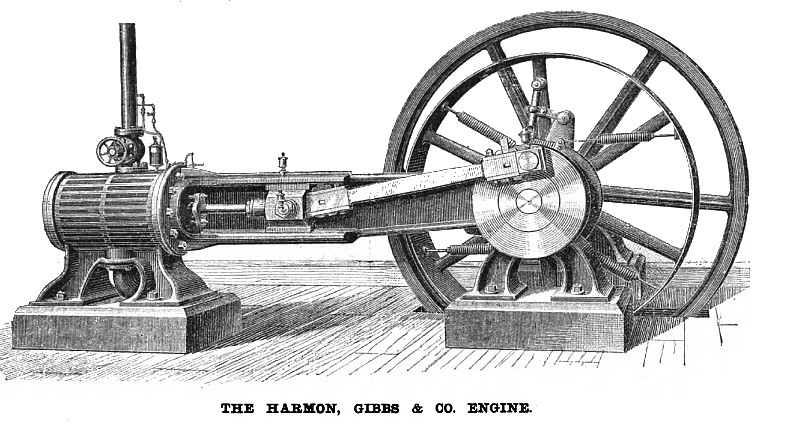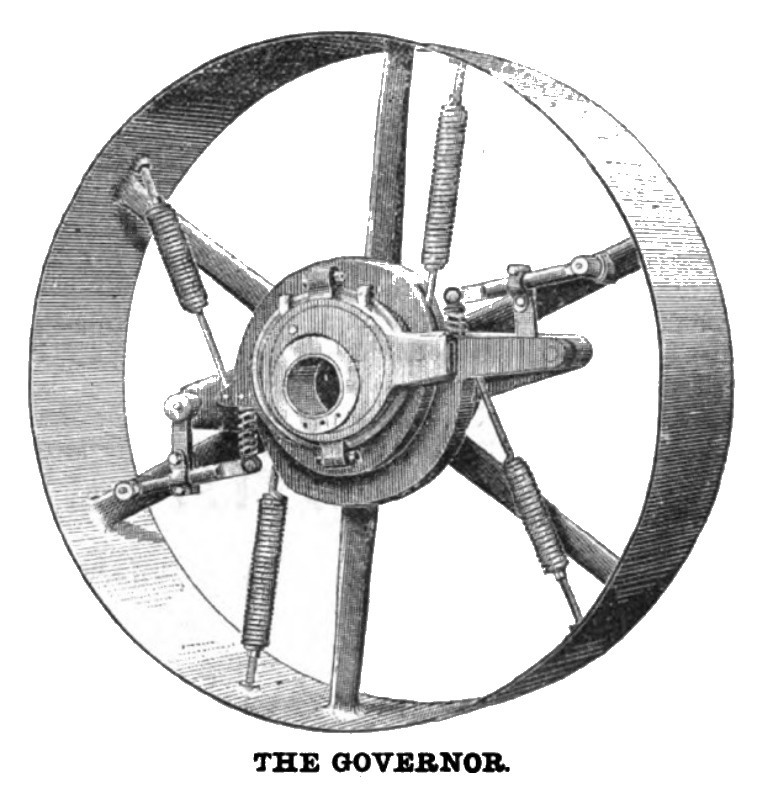|
Title: |
1884 Article-Harmon, Gibbs & Co., Ajax Steam Engine |
|
Source: |
Electrical World, V 3, #14, 05 Apr., 1884, pg. 109 |
|
Insert Date: |
3/7/2025 9:53:04 PM |
THE HARMON, GIBBS & CO. ENGINE.
In the preceding article of this series we described a new and ingenious method of regulation invented by Mr. F. H. Ball and we analyzed its operation in the Ball automatic cut-off engine in which it has been successfully embodied. We emphasized the usefulness and the desirability of this new method by showing that it involves the true principle of correct and precise regulation, making the load itself gauge the supply of steam admitted into the cylinder. To show its adaptability under varied conditions of power and speed we present it herewith in a new form of single-valve automatic cut-off engine manufactured by Messrs. Harmon, Gibbs & Co., of Corry, Penn. (Fig. 1), the Ball governor (Fig. 2) being used with a different type of engine.
The Ball engine, it will be remembered, is made in three standard sizes only, ranging from 20 to 60 horse-power. This engine is made specially for high speed, and therefore the length of stroke is short as compared with the diameter of the cylinder. The engines manufactured by Messrs. Harmon, Gibbs & Co., are intended for higher power, and are made in five standard sizes ranging from 60 to 150 horse-power or above. In this case a very high speed of rotation is not aimed at. The length of stroke is made longer as compared with the diameter of the cylinder, so that, though the piston travel may be as many feet per minute, the speed of rotation is lower. The sizes of the smallest type are 12 X 16 and of the largest 20 x 30. The normal speeds for which these engines are built, varies from 175 revolutions for the smallest size, to from 80 to 100 for the largest. The firm makes a specialty of the second size, known as “No. 7," having 12 x 20 cylinder and intended for a normal speed of 155 revolutions. Of course, the speed of these engines may be varied considerably above or below the point at which they are adjusted, by regulating the tension of the governor springs, and for special purposes requiring it, they may be constructed to run normally at higher speeds than those given. The driving pulley has a diameter of 72 inches in the first four sizes of engine, and of 96 inches in the largest size, though these may be replaced by even larger pulleys. These engines would therefore drive dynamo electric machines at a sufficient speed when belted direct, though they are specially adapted to cases where several dynamo-electric machines are driven by a single engine of higher power by means of a countershaft.
The frame is of the girder type patterned after the Corliss frame. In this respect the engine is anomalous, for it is, as far as we know, the only single-valve automatic engine, which has this form of frame. The pedestal at the crank end on which the main bearing rests is cast in one piece with the frame. The bearing at the outer end of the crank-shaft is also of a pedestal form and rests on a foundation level with the other pedestal and with the pedestal supporting the cylinder. This pedestal is cast in one piece with the cylinder and steam chest. The cylinder is secured to the turned flange on the end of the girder frame by means of bolts passing through the flange and the inner head of the cylinder. The cross-head has adjustable brass gibs which slide on guides of ample wearing surface, forming part of the frame itself. The wrist-pin and crank-pin are of steel and of large size.
Lubrication is provided for at all the moving parts by sight-feed oilers. The ports are made large. The valve is a plain balanced slide pattern, and it is accurately fitted in its seat by careful scraping. The valve gear, eccentric mechanism, etc., being exactly identical in construction and operation with that in the Ball engine. require no special description here. Everything that has been said regarding the Ball governor and its working in the preceding article will apply in this case. These engines are said indeed to govern with almost absolute perfection and precision, the fluctuations experienced under great variations of load being well-nigh imperceptible.
These engines may be said in a measure to fill the gap between the high speed and the slow speed engine at the same time that they simulate in appearance a phase of evolution of the one to the other. It might be also that they hold the same relative place in point of comparative cost and economy. Their extreme simplicity of construction is favorable so far as first cost and the expense of repairs are concerned. On the score of economy of fuel in running the makers claim for them results equal to those of engines having the best and most complicated cut-off gear. But even conceding a point to the Corliss engine in this respect, the Harmon, Gibbs & Co. engine is worthy of where a single engine is required to drive several dynamo electric machines, because its higher speed of rotation allows less slackening as the crank passes the dead centre and specially, because it is capable of quick, close regulation. |
|
 1884 Harmon, Gibbs & Co., Ajax Steam Engine
1884 Harmon, Gibbs & Co., Ajax Steam Engine
 1884 Harmon, Gibbs & Co., Ajax Steam Engine Governor
1884 Harmon, Gibbs & Co., Ajax Steam Engine Governor
|
|